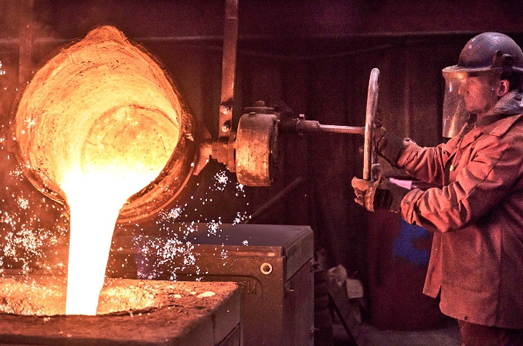
Calcium additions increase fluidity of the liquid steel, reduce oxide inclusions and modify their composition and shape. This makes steel much more isotropic, improving ductility and toughness.
For welding rod steel, Ca transforms inter dendritic Al2O3 galaxies into softer Type III inclusions that do not clog continuous casting nozzles. This also improves machinability and through-thickness ductility.
The calcium treatment (CaT) improves steel cleanliness, desulphurizes it, and reduces directional anisotropy. It has also been shown to retard corrosive damage in halide-rich environments.
The corrosion inhibition effect of Ca is primarily due to the formation of a protective equiaxed ferrite coating on the surface of mild steel. However, recent work suggests that the morphology of inclusions is also important. In this regard, the addition of Ca can change the shape and size of inclusions to favor a non-corrosive globular phase.
This is supported by the results of an experimental investigation carried out on API P110 steel immersed in various brines containing different levels of CaCl2. VSI was used to quantitatively and statistically analyze the three-dimensional (3D) corroding surface topographies. In particular, the frequency distribution curves representing the average height changes of corroding surfaces were normalized and compared between the cases where the sample was exposed to the brine in the absence or presence of the inhibitor.
A calcium treatment can transform high melting point inclusions into low melting point complex non-metallic inclusions by controlling the inclusion composition, morphology and quantity in the molten steel. It is shown from industrial experiments and thermodynamic calculation that a suitable calcium content can generate spherical inclusions with a composition between C3A and C12A7 with low melting point.
Moreover, the calcium treatment can modify the shape of manganese sulfides from elongated stringers into (Ca,Mn)S inclusions with a spherical morphology, which is beneficial for the through-thickness ductility and toughness. As a result, the calcium treatment quality plate steels can resist the lamellar tearing during welding and fabrication processes and have improved room temperature impact properties and fatigue thresholds.
This paper compares the tensile properties, room temperature impact properties and fatigue crack growth rates of steels with and without calcium treatment under simulated submerged arc corrosion conditions. The results show that the tensile strength, impact properties and fatigue crack growth rates of the calcium treated steel are higher than those of the non-calcium treated steels.
The ability of metal to stretch under tensile stress without breaking is called its ductility. It’s an important property because it reveals how much force can be applied to a structure before it fails. It can also help to predict which type of failure mode a material will experience, and whether it will snap like an elastic band or deform into a thinner shape before failing.
The warmer a material is, the more ductile it becomes. The reason is that heat adds thermal energy to metals, easing the friction between atoms and greasing the dislocation planes that can cause them to slip. Ductility is often correlated to malleability, with face-centered cubic materials being more ductile than body-centered or hexagonal close packed ones.
Calcium addition can change the composition, morphology and size of inclusions in molten steel. These include silicates, oxides and sulfides. They can also influence the ductility of steel by changing their concentration and distribution within the melt.

The calcium treatment has two main effects on toughness. First, it modifies the composition and shape of the complex non-metallic inclusions (cNI) in the liquid steel. Normally the cNI are spherical in shape and occupy a corner of the Al2O3-CaO region in the ternary system phase diagram. The Ca in the calcium wire reacts with the surface of the cNI and changes it into magnesium aluminate spinel. The globular shape of the resulting inclusion means that it can no longer form a plane of weakness that causes tensile failure and cracking in welds. It also prevents the formation of sulfide stringers, which can cause elongated cracks in rolled products.
Finally, calcium prevents the reoxidation of low melting point inclusions such as alumina(Al2O3) and silicate which are harmful to ductility and impact strength in the steel. This reduces the occurrence of inter dendritic Al2O3 galaxies in the steel, which are known to clog continuous caster nozzles.

Write a Message